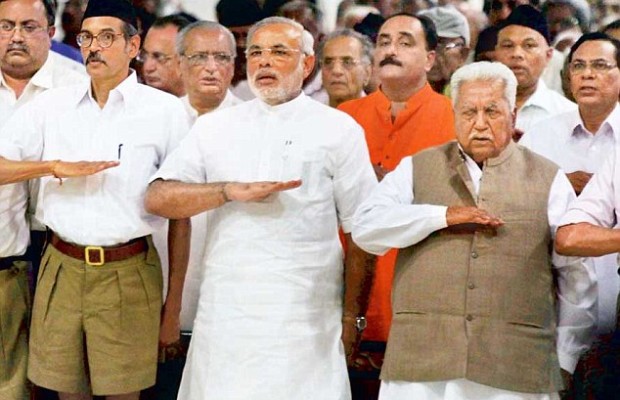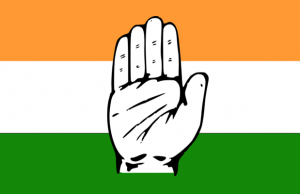A NATION WITH FINGERS CROSSED

When it comes to implementing its divisive agenda.
Prime Minister Narendra Modi’s an hour long speech after the discussion on the commitment to India’s Constitution as part of 125th birth anniversary celebration of Dr. Bhim Rao Ambedkar in Lok Sabha on Friday evening was mere cosmetic. After listening to two days’ debate I expected Modi to address the issues currently challenging the basic socio-economic fabric of India. But Modi chose to be philosophical by heavily quoting from here and there, and chanting rhetorical Sanskrit sayings in which the ideology he follows has no faith.
Modi preferred not to answer to some vital issues raised by Congress President Sonia Gandhi in her speech. He had no answer to why there is a situation where whatever being witnessed over the past few months was totally against the principles of the Constitution? Modi did not find the issue of increasing incidents of intolerance and his tactical silence over the statements of his ministers, party leaders, and even governors worth touching in his speech. Though the speaker of Lok Sabha, Sumitra Mahajan, mentioned the names of leaders who played an important role in drafting the constitution, Modi focused only on Ambedkar and very carefully avoided giving any credit to other leaders.
Modi must recall that when the Constituent Assembly met for the first time on 9 December, 1946 (interestingly, it is the date and year of Sonia Gandhi’s birth too) in the Central Hall of Parliament House those who adorned the front row were Jawaharlal Nehru, Maulana Abul Kalam Azad, Sardar Vallabhbhai Patel, Acharya J.B. Kripalani, Dr. Rajendra Prasad, Sarojini Naidu, Hare Krishna Mahatab, Govind Ballabh Pant, Dr. B.R. Ambedkar, Sarat Chandra Bose, C. Rajagopalachari and M. Asaf Ali. Six members of the Constitute Assembly played particularly important roles in making the constitution. Three of them were Nehru, Patel, and Rajendrababu. It was Nehru who moved the crucial “Objectives Resolution”, as well as the resolution proposing that the National Flag of India be a horizontal tricolour of saffron, white, and dark green in equal proportion, with a wheel in navy blue at the centre.
Patel also played a key role in the drafting of several reports, and working to reconcile opposing points of view. Rajendra Prasad’s role, as President of the Assembly, was to steer the discussion along constructive lines. Besides this Congress trio, a very important member of the Assembly was Ambedkar. During the period of British rule, Ambedkar had been a political opponent of the Congress; but, on the advice of Mahatma Gandhi, he was asked at the time of Independence to join the Union Cabinet as Law Minister. In this capacity, he served as Chairman of the Drafting Committee of the Constitution. Serving with him were two other lawyers, K.M. Munshi from Gujarat and Alladi Krishnaswamy Aiyar from Madras, both of whom gave crucial inputs in the drafting of the Constitution. These six members were given vital assistance by two civil servants—B B.N. Rau, Constitutional Advisor to the Government of India, who prepared a series of background papers based on a close study of the political systems obtaining in other countries. The other was the Chief Draughtsman, S. N. Mukherjee.
Since the beginning, Rashtriya Swayam Sevak Sangh (RSS) was against the basic spirit of the constitution and adopting tricolor as the national flag. When the Constitution was being formulated an editorial appeared in RSS mouthpiece Organiser expressing dismay that Constitution contained nothing “Bhartiya” and that it had hardly borrowed anything from the staggering work of Manu—‘Manusmriti’. Devoid of Manu’s laws when Constitution came into effect on 26 January 1950, disgruntled RSS published a piece titled “Manu Rules our Hearts” in the issue of their mouthpiece, organiser, dated 6 February 1950. It is not a hidden fact that from Vinayak Damodar Savarkar to Guru Golwalkar to Mohan Bhagwat all the leaders of right wing Hindu organisations have been worshipers of Manusmriti, and Dalit leaders and organisations have always been burning the copies of Manusmriti. In spite of the rigorous exercise of studying the best practices of various constitutions before drafting of our own, to RSS it was an act of betrayal by the Constituent Assembly. RSS then reacted by saying, “Manu’s Laws were written long before Lycurgus of Sparta or Solon of Persia. But to our constitutional pundits that means nothing.”
RSS was also against adopting tricolor as our national flag. Guru Golwalker, for 33 years the chief of the RSS and its most influential ideologue, was equally opposed to fighting the British. On 14 August 1947, at the dawn of Independence, the Organiser, openly denigrated the choice of the tricolour as the National Flag and said, “the Tricolour will never be respected and owned by Hindus. The word three is in itself an evil, and a flag having three colours will certainly produce a very bad psychological effect and is injurious to a country.” Modi must be well aware of these historical facts as he has written a book dedicated to Golwalkar titled “Shree Guruji: Ek Swayamsevak”. But, when it comes to implementing its divisive agenda, RSS has a mastery over the art of deliberately ignoring fundamental facts. Therefore, it is easy for Swayamsevaks to forget the most auspicious presence of “Tridevas”—Brahma, Vishnu, and Mahesh in our mythology.
RSS is an admirer of Hitler and dictatorship over democracy. When the Congress launched the Quit India movement in 1942, Savarkar opposed it and asked Hindus to enlist in the British armed forces. As President of the Hindu Mahasabha in 1937, he had advanced the slogan “Hinduise all Politics and Militarise Hindudom”. In his 1938 book Golwalkar approves the Nazi extermination of Jews and said, “national pride at its highest has been manifested here.” Who else than RSS would realise the benefits of not having a Constitution at all as it had no written constitution and no official list of members, so it could never be proved that RSS was involved in Gandhi’s murder.
After decades of unpopularity, the rehabilitation of the RSS came from an unlikely source, the Gandhian Socialist Jayaprakash Narayan. JP had a wishful thinking that the communal mindset of the RSS would be transformed and when Indira Gandhi called the RSS fascist, JP famously declared, “If the RSS is fascist, then I’m a fascist too.” Today, we have 17 out of 23 Union Cabinet Ministers with RSS roots, apart from Modi. If the nation is sitting with its fingers crossed, whose responsibility it is to create an atmosphere of ease of living with harmony?




You must be logged in to post a comment Login